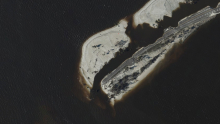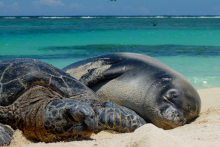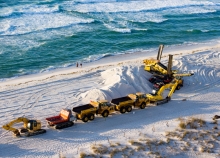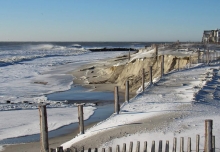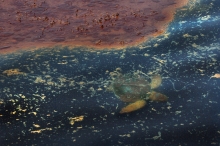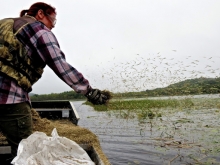In 2024, NOAA and co-trustees secured $40 million from four hazardous waste pollution settlements for the restoration of U.S. waterways.
A natural disaster such as a hurricane impacts all facets of life in a community, and can even cause ripple effects that spread beyond the area of landfall to impact distant places and people. This far-reaching impact can be a devastating reminder of the interconnected nature of the blue economy, connecting people across the globe through sustainable economic activity alongside environmental protection. NOAA’s Office of Response and Restoration (OR&R) supports this blue economy through response and planning activities that protect critical infrastructure and marine resources, as seen in the 2022 response to Hurricane Ian in Florida.
Protecting Protected Species: Breaking Down How NOAA Helps Conserve Protected Species as Part of its Mission
By Dale Youngkin, NOAA's Office of Protected Resources
alyssa.gray
Tue, 01/25/2022 - 22:41
A whale breaching out of icy water, a sea turtle crawling onto the sandy shore to lay eggs, or a salmon swimming upriver to spawn, few species capture our hearts and imaginations more than protected species. However, it wasn’t until relatively recently that they were protected under U.S. law.
The Deepwater Horizon oil spill began on April 20, 2010, with a blowout of BP’s Macondo drilling platform in the Gulf of Mexico. In addition to the death of 11 men, the spill resulted in the largest mobilization of resources addressing an environmental emergency in the history of the United States. The size of the spill required the Emergency Response Division to refine tracking subsurface oil, flowrate calculations, and long-term oil transport modeling. Data and information management became a paramount issue ...
ESI Specialist Jill Petersen Looks Back on Career Built Around Sensitivity Mapping
alyssa.gray
Thu, 11/14/2019 - 13:03
This week, we’re taking a closer look at what sensitivity mapping is, how it’s used, and why it’s so important. A snapshot of the resources in a specific area, sensitivity mapping can be a valuable tool both in and out of the spill response community. In this latest blog, learn more about where sensitivity mapping first got its start, and how mapping specialist Jill Petersen has seen it grow throughout her career.
What is Sensitivity Mapping, and Why is it Important?
By Donna L. Roberts, Office of Response and Restoration
alyssa.gray
Tue, 11/12/2019 - 12:23
This week, we’re taking a closer look at what sensitivity mapping is, how it’s used, and why it’s so important. A snapshot of the resources in a specific area, sensitivity mapping can be a valuable tool both in and out of the spill response community.
Threats to Sea Turtles from Oil Spills: Lessons Learned During a Disaster
By Megan Ewald, Office of Response and Restoration
alyssa.gray
Tue, 06/11/2019 - 18:16
Few animals capture the human imagination like sea turtles. Sea turtles are living fossils, they have glided through the Earth’s oceans for over 110 million years. But today, sea turtles face new, human-caused threats that put all seven species at risk of extinction. One of these threats is oil spills.
Spotlight on People and Pollution: Wild rice, pollution, and space for traditions to grow
By Megan Ewald, Office of Response and Restoration
alyssa.gray
Tue, 03/05/2019 - 14:20
When people look out on the Great Lakes for the first time, they often compare them to the ocean. In some ways the analogy works. The five Laurentian Great Lakes are incredibly vast, when you stand on the shore of Lake Superior there’s nothing but steely blue water until the lake meets the horizon. If all you saw was a photo, you could mistake it for the ocean.
12 Days of NOAA Trust Resources
By Megan Ewald, Office of Response and Restoration
alyssa.gray
Thu, 12/20/2018 - 17:49
♫ If you go to the coastline, you’ll find swimming free... ♫
Twelve drums a drumming,
Eleven plovers piping,
Ten eels-a-leaping,
Coordination is Key: Moving toward restoration at the St. Louis River Interlake/Duluth Tar site
Annie Gibbs, NOAA Office of Response and Restoration
alyssa.gray
Thu, 03/15/2018 - 18:54
The St. Louis River/Interlake/Duluth Tar site was used for a variety of industrial purposes — including coking plants, tar and chemical companies, the production of pig iron, meat-packing, and as a rail to truck transfer point for bulk commodities — starting near the turn of the 19th century. In 1983, the St. Louis River Superfund site was added to the National Priorities List.
In November of last year, a settlement was reached between the trustees for the site and the parties responsible for the contamination. The settlement includes funds for the following restoration projects ...

